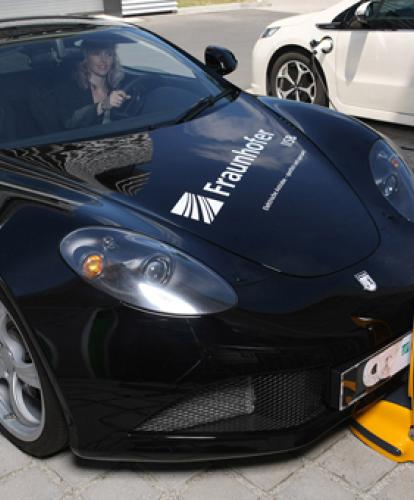We can already charge our toothbrushes, mobiles and other gadgets using contactless technology. But now, researchers have developed a particularly efficient and cost-effective method that means electric cars could soon follow suit.
Dr. Bernd Eckardt, of the Vehicle Power Electronics department at the Fraunhofer Institute for Integrated Systems and Device Technology (IISB) in Erlangen, Germany who heads up a team of researchers developing wireless charging technology for electric vehicles said: “Cables are annoying, especially in winter or when it’s raining. Whatever gets on the cable – snow, sludge, water – also gets on your hands,”
Dr. Eckardt knows what he’s talking about, because he drives an electric car himself. It would be much more convenient to charge these plug-in vehicles remotely with contactless technology.
The way to do it is using electromagnetic induction, whereby electrical energy is transferred over the air between two objects via an electromagnetic field. Dr. Eckardt explains the physics behind it as follows:
“Any wire that carries a current generates a magnetic field. As the English physicist Michael Faraday demonstrated in the 19th century, this magnetic field generates voltage or electromotive force as well. By correctly positioning two wires in relation to one another inside a magnetic field, it is possible to transmit energy over the air.”
Familiar examples of products that use this kind of energy transfer include charging stations for electric toothbrushes, mobile phones, and induction hobs.
Researchers from the scientific and industrial communities have been working for several years to find ways to use induction to charge electric vehicles. The current approach involves mounting induction coils on the underside of the vehicle and installing charging stations in the ground. But this brings with it a number of significant challenges.
The coils need to be very powerful for the method to work because of the significant gap of up to 15 cm between car and ground. Powerful coils are large in size – and large coils are expensive, which pushes up costs. There is also the problem of objects or animals impeding the charging process by blocking the transmission of power. Cats, for example, are attracted by the gentle warmth emitted from the charging station in the ground.
Another particularly problematic issue is that metallic paper such as chewing-gum wrappers or cigarette packaging can blow under the car and into the induction zone, where it can get so hot that it bursts into flame.
Researchers at the IISB began pursuing an alternative approach in a bid to resolve these problems. Working as part of the Energie Campus Nürnberg research platform it took them less than a year to develop a system for charging electric vehicles from the front end. Since this allows the car to be driven much closer to the induction source – essentially touching it – the coils themselves are much smaller in diameter than in the floor-based version, coming in at 10 cm instead of 80 cm across.
The system is more efficient, more cost-effective and makes it less probable that obstacles will disrupt the flow of energy. The charging column is approximately waist-high and made of plastic. It bends backwards if pushed by the vehicle, and is even designed to flip down and out the way if the pressure applied is too strong.
“The car could drive over it if necessary. Touching the charging station causes no damage to the car body,” says Eckardt. The coils are arranged in such a way that charging can take place even if the driver has not positioned the vehicle exactly in front of and centrally to the column. Clusters of coils that overlap vertically in the column and horizontally behind the license plate allow the current to flow irrespective of the vehicle’s size or height.
“We’ve been consistently upping the system’s performance over the past year, and are now in possession of a prototype that is able to transmit three kilowatts (kW) at an overall efficiency of 95 percent.” says Eckardt.
The researchers are now looking to further increase the power of the coil, primarily to keep up with developing battery technology, and to cut the cost of the charge spot even further. “Nowadays, charge spots are offered as part of the sales package when customers buy an electric vehicle. This technology will only become a mass product if the price is right,” Eckardt explains.
Fraunhofer Institute



